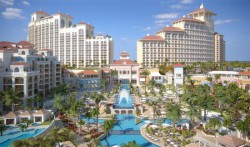The monitoring is being done through the independent Great Guana Cay Foundation, a non-profit partnership between the developers and both the University of Miami and the College of the Bahamas.
The foundation’s mission is to ensure that the 566-acre development follows guidelines set out by the Environmental Impact Assessment, and to undertake public education and outreach activities.
Although the EIA was underwritten by the developer, it was researched and produced under an arm’s length grant to the University of Miami, which is solely responsible for its content. Marine biologist Dr. Kathleen Sullivan Sealey was the principal investigator and leads the project’s environmental management team.
She is an approved consultant for the BEST Commission, which is responsible for environmental oversight in the Bahamas. Working under her are University of Miami doctoral students Nicolle Cushion, Kate Sermon and Cloe Waterfield; and Keith Bradley, a botanist from the Institute for Regional Conservation.
“The web site is located at www.saveguanacay.com,” said Larry Smith of Media Enterprises, the Bahamian communications agency that developed the site content and architecture. “It offers accurate and in-depth information on everything from economic impacts and housing density to marina flushing and plant conservation. It is not a marketing tool.
“In addition to research reports and relevant articles and news items, the site will soon feature real-time feeds from a solar-powered weather station at Baker’s Bay as well as webcams strategically placed around the development. There will also be a number of streaming video links.”
The main environmental goals of the Baker’s Bay Club are to preserve 80 per- cent of the island’s native vegetation, to maintain groundwater and near shore water quality, to enhance wildlife habitat in protected areas, and to promote coastal stability.
“We are establishing an innovative model for post-EIA monitoring and management,” according to Dr. Livingstone Marshall, senior vice president for environmental and community affairs. “Regular reports submitted to the BEST Commission will be posted on the web site. And the island’s heritage preserve, as well as other special conservation areas ヨ including mangrove wetlands, dune systems and shoreline buffer zones ヨ will be closely monitored at all times.
“We aim to create a low-profile resort community with natural landscapes and vistas preserved. Residents will be able to understand and appreciate the true Bahamian environment in its natural state. This is a project for the next generation, who value working with the environment instead of trying to alter it.”
Among the documents that have been or soon will be posted on the web site are the full EIA approved by the BEST Commission, reports on coastal ecology in the Bahamas, and articles on remediation of the abandoned cruise ship shore facilities, marina and golf- course design, solid waste and water management, and plant conservation.
“Many of these will be downloadable PDF files, including environmental incident reports,” Mr Smith said. “There will also be a contact form for site visitors to communicate directly with both the developers and the science team. No other comparable development in the Bahamas has ever agreed to such close environmental scrutiny and guidelines, and the web site makes this crystal clear.”
The Baker’s Bay property occupies about half of the 1,100-acre cay. When completed, the community will feature some 400 residential units, 75 villa-style rooms, a golf-course, a180-slip marina, a beach club, a commercial centre, employee housing and central services.
But more than two-thirds of the development’s 566 acres will remain open space. This will include the heritage preserve, the golf- course, coastal setbacks and easements. Only 17 percent of the land will be used for residential purposes. The overall project density ヨ considering both employees and residents ヨ is 1.67 per acre.
There are currently 243 buildings in the Guana Cay settlement at the other end of the island, and under 200 full-time residents. But there are other residential developments on the island with 49 private docks and two commercial marinas. Some 450 home sites are for sale both north and south of the settlement.
Baker’s Bay will set an example for these developments that will be hard to match. Housing covenants will focus on maintaining the island’s natural heritage. Building will be restricted in buffer zones, which will be landscaped with primarily native plants. Proper water and waste management guidelines will be followed.
Source: The Freeport News



